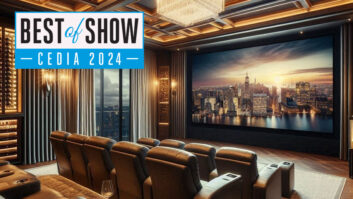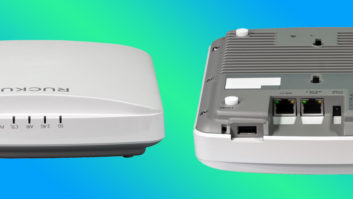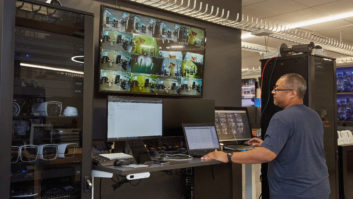Handheld Remotes Show No Signs of Being Crowded Out by Tablets

By combining familiar hard buttons for media functions with a touchscreen for whole home control, ELAN’s HR2 remote features a design that is familiar to anyone who has used a remote control, but offers far more functionality.
If tech news in the last three years were lumped together by product, one might guess that Apple’s iPad and its apps accounted for at least half of stories written. Tablets have the advantage of the zeitgeist, but our industry isn’t one to carelessly abandon proven, reliable technology.
The handheld, wand-style remote control shows no signs of being crowded out, despite the flashiness of tablets. Consumers still demand a dedicated remote, and a number of companies recently introduced innovative new products to meet their needs.
According to Pete Baker, RTI’s vice president of sales and marketing, his company views tablets and other mobile devices as added benefits to a dedicated controller–not replacements.
“There are a number of reasons why consumers still prefer a handheld remote control,” Baker said. “First, tablets are primarily used for games, reading, surfing the web, and other activities. So the device can easily wander off and not be fully charged or readily available for use as a controller when needed.
“These devices lack hard buttons for tactile control, which offer a more comfortable and convenient user experience. Handheld remotes also provide instantaneous control–no screen swiping and no dependence on the Wi-Fi network.”

RTI’s entry-level Pro Control brand offers the PRO-24.z.
Joe Lautner, manager of business development and project management at ELAN Home Systems, agreed that tablets, smartphones, and in-wall touch panels are good for many things and are “passable as media remotes.” But, he noted, they also require several clicks to get to a required function. “People are used to instantly changing the channel, turning down the volume, or pausing their movies with one click, not several,” he noted. “These on-demand functions are only possible with wand-style remotes that feature dedicated hard buttons. Instead of having to look up to your screen and back down at your touchscreen, you can perform all functions with one easy-to-use wand-style remote.”
Crestron’s technology manager for touchscreens and user interaces, Byron Wendling, said that in a handheld remote there are so many performance expectations that must be weighed. “You can have all the fancy features in the world, but the core simplicity and reliability must remain intact,” he said. “In other words, what’s cool must always be carefully balanced with what works so that the product can represent the best of both worlds.”
Crestron recently delivered the MLX- 3 handheld wireless remote, a long-range remote control with a 2-inch high-resolution LCD. The MLX-3 features the company’s “instant-waking” technology for eliminating lag time.

URC’s MX-1200 is always ready to pause or play a movie at the touch of one button–no need to flick through pages of menus to find a command. It’s also dedicated to controlling the house.

The Savant Select allows users to integrate an iPod touch into the remote, with traditional backlit buttons and essential navigation keys.
“Our wireless technology provides ultra-reliable two-way communications,” Wendling added. “Instant-waking has been engineered to power on the remote instantly, at the press of a button. Extended battery life and simplified programming make it an intuitive remote with great benefits. Our remote works like an IR remote with all the benefits of two-way RF.”
Hybrid Options
Rather than favoring one style of control over another, some manufacturers are finding ways to offer customers a hybrid style. For instance, by combining familiar hard buttons for media functions with a touchscreen for whole-home control, ELAN’s HR2 remote features a design that is familiar to anyone who has used a remote control, but offers far more functionality.
“Some people have become so reliant on their smartphones and tablets that they want to use them for their media control,” Lautner said. “When we designed the ELAN HR2, we aimed to create a sleek, stylish remote control that can perform any and all functions of the g! home control system quickly and easily and show the users how much easier it really is.”

The MLX-3 features the Crestron’s “instant-waking” technology for eliminating lag time.
RTI’s Pro Control entry-level brand offers a line of handheld controllers created to provide one-touch simplicity by “taking the best from popular mobile devices,” according to Mike Everett, general manager of the brand. The controllers feature a high-resolution, 2.4- inch TFT LCD touch-screen that enables one-touch control, with a built in a programmable five-way joystick to give users fast access to key functions, and backlit hard buttons to make device navigation easy in a darkened room.
In addition, Pro Control recently revealed the iPro.8 companion controller. “When combined with a tablet, smartphone, or PC for AV control, the iPro.8 allows users to enjoy the convenience of a dedicated remote by providing the hard buttons and tactile control to which they are accustomed, in addition to immediate access to common functions such as changing channels or volume,” Everett said. “The iPro.8 companion remote has patent pending technology which stays in sync with the tablet or smart phone and allows seamless communication when switching between mobile device and the companion remote.”
Savant Systems took a unique approach when it unveiled its Savant Select, which integrates an actual iPod touch into the remote, with traditional backlit buttons and essential navigation keys surrounding it. The remote takes advantage of Savant’s TrueContol II app and delivers immediate system access with a few taps or swipes of the 3.5- inch color multi-touch retina display.
Savant Select is also compatible with TrueCommand, Savant’s on-TV menu system overlaid onto live HD video. Paired with TrueCommand, Savant Select provides heads-up navigation, browsing and selection of multimedia content, and other services. By using TrueCommand in tandem with Savant Select, users can navigate and switch to any device in the home.
Ready When Your Are
Cat Toomey, director of marketing for URC, stressed that the readiness and speed of a dedicated remote remains a major advantage over other devices.

RTI’s SURFiR remote allows users to utilize their smartphone and tablet devices as the main graphical interface for their control system while adding the convenience of tactile control with hard buttons.
“Our MX-1200 is always ready to pause or play a movie at the touch of one button–no need to flick through pages of menus to find a command. It’s also dedicated to controlling the house, so it’s always where you need it when you need it,” Toomey said.
By combining functionality with flexibility, these products expand the capabilities of wandstyle remotes while dodging the shortcomings of touchscreen devices.
RTI’s most recent handheld device–the SURFiR companion remote–was designed to overcome the limitations of tablets and smartphones as primary controllers, delivering what Pete Baker calls, “elements of a robust, high-end control system, including userfriendly ergonomics, instant connectivity, and highly reliable operation.”
The SURFiR remote allows users to utilize their smartphone and tablet devices as the main graphical interface for their control system while adding the convenience of tactile control with hard buttons. SURFiR automatically controls the electronics that are being used, eliminating the numerous screen swipes needed for control tasks that require frequent interaction, such as watching TV.
URC’s Toomey sees increased opportunities for the future with new and novel forms of control such as gesture and voice control.
“While we don’t necessarily believe that either of these technologies will dominate the category anytime in the near future, in our constant effort to push the envelope, we’re studying these and other emerging control methods,” Toomey said.
Baker warned that convincing some smartphoneobsessed clients not to rely only on a touchscreen may still be a challenge.
“Dealers should be careful not to hang their hat entirely on a smartphone or tablet interface,” Baker said. “To ensure the ultimate customer satisfaction, every system should include some form of a professional control device with the added benefit of access through a smartphone or tablet PC.”
The real challenge,” said Pro Control’s Everett will lie in helping users to find the best solution for their needs. “While we recognize that the availability of mobile control apps can be liberating and exciting, we want to be sure that customers are getting solutions–both dedicated and mobile–that provide lasting utility and long-term satisfaction with the user experience.”
Derek Dellinger is web editor of Residential Systems and Systems Contractor News.







